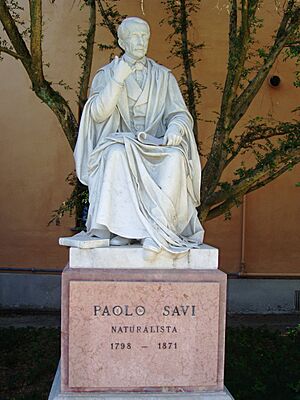Paolo Savi facts for kids

Paolo Savi (born July 11, 1798 – died April 5, 1871) was an important Italian scientist. He was a geologist, meaning he studied the Earth's rocks and how they were formed. He was also an ornithologist, which means he studied birds. Savi made many discoveries about both geology and birds in Italy.
Contents
Life and Work of Paolo Savi
Paolo Savi was born in Pisa, Italy. His father, Gaetano Savi, was a professor of botany (the study of plants) at the University of Pisa.
Becoming a Professor
Paolo followed in his father's footsteps in science. In 1820, he started working at the University of Pisa as an assistant teacher of zoology (the study of animals). Just three years later, in 1823, he became a full professor. He also taught about geology.
Building a Great Museum Collection
Savi spent a lot of time working on the university's museum, which is now called the Natural History Museum of the University of Pisa. He helped create one of the best natural history collections in all of Europe. This collection included many different types of rocks, fossils, and animal specimens.
The Father of Italian Geology
Many people consider Savi to be the "father of Italian geology." He carefully studied the mountains in Italy, like the it:Monti Pisani and the Apuan Alps. He was one of the first to explain how Carrara marble was formed from other rocks through a process called metamorphism. He also wrote about ancient layers of rock from the Miocene period and the fossils found in them. Savi also studied the iron ores found on the island of Elba. With another scientist, Giuseppe Meneghini, he published important papers about the rocks and geology of Tuscany.
Studying Birds: An Ornithologist
Paolo Savi was also a very skilled ornithologist. He wrote two major books about birds in Italy: Ornitologia Toscana (published between 1827 and 1831) and Ornitologia Italiana (published after his death, from 1873 to 1876).
One of his most famous discoveries was a new type of bird. In 1821, he found specimens of a small, brown bird that had never been described before. He wrote a full description of this bird in 1824. Today, this bird is commonly known as Savi's warbler, named in his honor.
Legacy
Paolo Savi passed away in 1871 and was buried in Pisa. A statue of him stands in the Orto botanico di Pisa, which is the botanical garden in Pisa.

